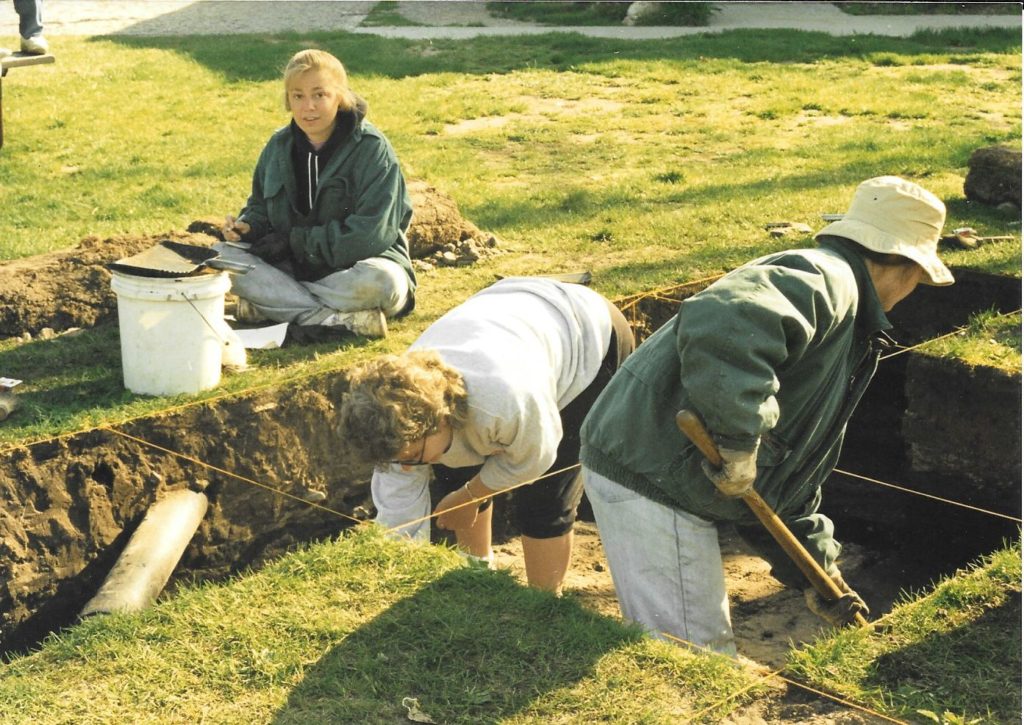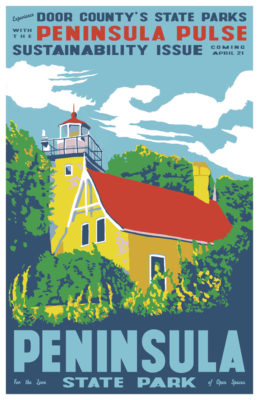Unearthing Artifacts: Evidence of Door County’s Earliest Settlers
- Share
- Tweet
- Pin
- Share

Victoria Dirst wanted to grow up to be an archaeologist, and she did — spending 21 years with the Department of Natural Resources. Her job was to investigate sites where building was proposed to make sure construction wouldn’t cover any archaeological treasures.
“I could pretty much tell from looking at a site if there was going to be anything there,” she says, “but if government money is involved, federal law requires a dig to verify that.”
For example, she and a few volunteers spent eight days in 1994 excavating a site on the beach in Peninsula State Park, referred to as Nicolet Bay or Shanty Bay, in preparation for a project to lay drainage tile. The site had been identified and recorded in 1917 by J. P. Schumacher, an amateur archaeologist.
Beneath a layer of landscaping fill, Dirst found cultural deposits — stone tools, animal bones and pottery — from several different times when the area was occupied, dating back 1,200 to 1,400 years. Human remains were also unearthed and preserved on site. The location was left unmarked to discourage anyone from digging up the bones.

(Left to right) Molly Ariens, Melody Walsh and Lori Bass-Edgar working at the Shanty Bay site. Photo by Victoria Dirst.
Dirst also was in charge of a dig at Whitefish Dunes State Park in 1986, prior to the construction of the nature center. Artifacts discovered there were similar to those unearthed at Shanty Bay, with evidence from about 100 BC to around the time Columbus “discovered” America. Natives, called the North Bay people, were the first residents, up to 300 AD, leaving shards of thick, gritty pottery in the dunes. Archaeologists value the information pottery provides, since it evolved more rapidly than stone tools and better reflects social relationships as tribes traded pots. The North Bay people probably arrived at the site in the spring, in time for sturgeon spawning, and stayed through part of the summer.
Next came their descendants, the Heins Creek people, who used the site from about 500 to 750 AD and began to grow corn and squash, probably with seeds obtained from other groups (beans, the third of the “Three Sisters” of the American Indian diet, came later). Evidence suggests this was a larger group than had been here earlier and that fishing was their main occupation. There are signs that the site, by then a substantial village, was home to two other groups from 800 to 900 AD. Like the earlier residents, they fished, then traveled to their winter hunting camps, where they lived in caves or rock shelters on the Green Bay side of the peninsula or on the edges of wetlands.
About 900 AD, the Oneota people appeared. They settled in the area twice, separated by more flooding. These people grew corn and squash, as well as fished and hunted. They had learned to grind the corn into flour, as the Whitefish Dunes dig unearthed seven charred black lumps that contained corn flour, an early form of bread that has not been found at other archaeological sites in the Midwest. The Oneotas may have lived at the site year round.
In recognition of the number of past occupations and excellent state of preservation, this site has been placed on the National Register of Historic Places.
All the digs Dirst conducted over 21 years were for the purpose of ensuring that planned building projects would not cover important archaeological evidence. In contrast, ongoing digs at Crossroads at Big Creek are aimed at educating children and adults through hands-on participation, as well as contributing to the knowledge of prehistoric life in Door County.
For the past three years, Midwest Archaeological Consultants (MAC) from Sturgeon Bay has been hired to conduct initial digs on property owned by Crossroads. Last year, Crossroads developed the Citizen Science/Educational Archaeology Program to involve the schools and community in the research. Grants from several funds of the Door County Community Foundation underwrote part of the cost.
In 2014, Crossroads acquired a 64-acre parcel of land from the Nature Conservancy. MAC conducted a preliminary survey on a small portion of the land along Ida Bay and discovered a landscape with a high potential for the existence of archaeological sites. A shovel-testing grid at 10-meter intervals was staked and mapped over the parcel. Results indicated that the site is a pure representation of North Bay culture around 200 BC – AD 250.
Last October, four MAC archaeologists — Randy Dickson, Jim Clark, Willy Kemps and Cassandra Tobin — came to Crossroads to teach elementary and middle school students and their teachers about Wisconsin prehistory, Native American stone tool making, the principles of scientific recording, systematic sampling design, washing and cataloging artifacts, principles of excavation and environment, and cultural adaptation.

Students help at the Ida Bay dig. Submitted.
A total of 450 students from Green Bay, Oshkosh, Sturgeon Bay, Washington Island, Sevastopol, a home school group and some Gibraltar children brought by their parents got to experience hands-on archaeology.
Among the artifacts they have found are North Bay-type projectile points (not really arrowheads, as bows and arrows didn’t appear until about 700 – 800 AD), pottery, chert knives, a copper awl, hammerstones, flake tools, antler tools, deer and other animal bones, and fire-cracked rocks. The students also learned to use a flot machine, a tool with a series of fine sieves that remove seeds and tiny bits of stone and bone from the soil.
Ultimately, the purpose of the project at Ida Bay is to create an educational environment that introduces students to the disciplines of archaeology with a hands-on approach in the field and the laboratory, including the interpretation of prehistoric cultural life.
Dickson told the students that when the early natives moved from a hunter lifestyle to one more centered on agriculture, it was not because agriculture was easier but as a result of being squeezed out of hunting grounds. Struggles to hold on to their territory caused warring between tribes. “Think the homicide rate is terrible today?” Dickson asks. “It was much worse then.”
All these early residents of Door County are thought to have been ancestors of the Menominee people, followed by Ho-Chunk/Winnebago, Pottawatomi and Huron.
Crossroads at Big Creek Director Coggin Heeringa says, “Never before has an activity so completely achieved the mission of Crossroads. The most gratifying part of the project was seeing students fully engaged, viewing learning as an adventure and connecting outdoor experiences to classroom endeavors. We heard comments like, ‘Oh, now I see why we learned to plot points on a graph.’” And, to a student who said he wanted an outdoor job like archaeology so he wouldn’t have to write, Dickson was quick to respond that he spends about 90 percent of his time at his computer, doing research and writing reports — 300 of them in 2015.
Forty adults from the community volunteered for the Ida Bay dig in 2015 and Heeringa says additional adult participation will be scheduled for fall 2016.
Crossroads also offered a graduate-level class, “Teaching Archaeology in the Elementary School,” through the University of Wisconsin — Green Bay. Nine teachers (three of them from three different Wisconsin tribes) participated in the digs and worked with the archaeologists to create curriculum materials for their own students that were also used with children participating in the dig at Crossroads.
Work at Ida Bay will continue this year, along with early explorations at Big Creek Cove, another Crossroads site discovered by Kemps, who had a “gut feeling” when he drove by the spot in the rain.
A final word: there are strict federal laws about the disturbance of archaeological sites by anyone other than qualified individuals with appropriate permits. Penalties for breaking the law range up to $100,000 and imprisonment.



